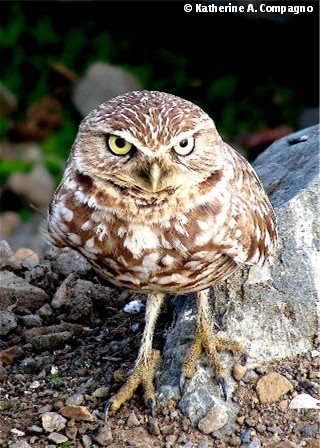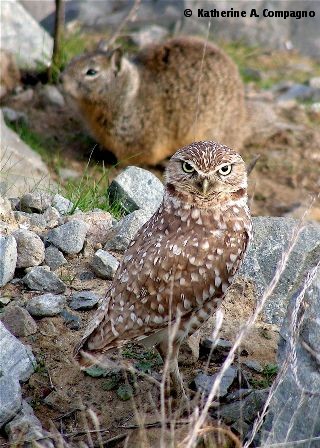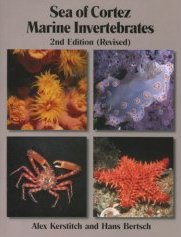Hey, Squirrel! There's an Owl in Your Digs
By Hans Bertsch
 It's
protective: prairie dogs stand alert, gophers buck-teeth a
peek, and ground squirrels skitter down with tails a-swish. But
an owl hooting underground from a burrowed home? Well, shake
your wings, bob your swiveling head, and blink those big yellow
eyes!
It's
protective: prairie dogs stand alert, gophers buck-teeth a
peek, and ground squirrels skitter down with tails a-swish. But
an owl hooting underground from a burrowed home? Well, shake
your wings, bob your swiveling head, and blink those big yellow
eyes!
You are a burrowing owl, lechuza de tierra,
buho pigmeo, or scientifically Athene cunicularia.
These sociable owls are a real
hoot, popping in and out of their commandeered burrows, cranking
their heads sideways while sitting on fence posts, and
scampering through air or scrubland to eat little mice, insects,
or the occasional frog or small bird. Especially enjoyed
insects are the juicy, water-rich grasshoppers, crickets and
beetles. They often nest in colonies, in the abandoned burrows
of not just ground squirrels and prairie dogs, but sometimes of
skunks, badgers, Texan armadillos, black chuckwallas, and even
Gopherus desert tortoises. Their scientific name is
from the Latin for “underground passage dweller,” or “miner.”
Burrowing owls occur in treeless
open grasslands and desert scrub throughout the western U.S.,
Mexico, Central and South America, and Florida and the West
Indies. Specimens have been found in various Pleistocene
deposits within that range.
First reports of burrowing owls
in Baja California (by S. F. Baird, 1874) were from the Cape
Region. We now know this species is widely distributed along
the low-lying sides of the entire peninsula, most commonly in
the northern and central regions. These landlubbers have also
been sighted on 23 islands, including most of the coastal
Pacific ones. In the Sea of Cortez, they have been reported as
“vagrant” (nonresident) on a dozen islands. They have even been
seen on little Isla Piojo at Bahía de los Ángeles. Although one
wouldn't consider burrowing owls to be marine birds,
investigators on board ships have watched them flying over water
to the islands.
Human activities seem to have
affected both their habitat abundance and population decline.
Eduardo Palacios and his colleagues reported (Western Birds,
2000) that in the peninsula, 43% of the species' sightings were
in agricultural lands (reflecting the abundant coastal farms and
human habitat use), and 18% in wetlands, 15% in the open desert,
and 12% in coastal sage scrub. At the same time “other human
activities such as poisoning and loss of nest sites through the
control of squirrels and prairie dogs” have diminished their
numbers to the point of being a “species at risk” in both the
United States and Mexico.
The bird stands 8–10 ½ inches
tall, with a wingspan of about 22 inches. Most owls have short
legs, but because of its terrestrial habits, these owls have
evolved much longer legs. They seem to have the most furrowed
brow of all owls—maybe in the vein of the High Plains Drifter
Clint-squint. A black eye crest often droops halfway over the
eye, and its white chin contrasts the black neck ring. Its
chest is whitish to mottled soft brown, and the brown
white-speckled wings vary in darkness throughout its range.
Its Athene relatives, the
Eurasian little owl (A. noctua) and the spotted owlet (A.
brama) of the Middle East, India and Indo-China, are forest
adapted, nocturnal owls, with more owl-typical shorter legs and
headlight eyes. The genus name is the Greek goddess of wisdom
and the arts, perhaps based on an equally legendary wise ole
owl.
Kids are definitely a family
affair. The clutch of 5–12 eggs is incubated for about 4 weeks
by both mom and pop, who also share in the feeding, training and
teen-age controlling. Spring and summer time at the Burrow
Owls' digs is a whirligig of practice fluttering and running.
They can imitate the “buzz” of a rattlesnake to frighten off
predators. However, a winged shadow passing across their
playground causes an immediate dive into their fortified
Predator Shelter. After a quiet lull, assured the danger has
passed, they all scurry topside to continue their 40 days of
lessons in growing up.
Life is a grand cabaret of
survival skills and antics: the “yawn” preceding their
regurgitation of undigestible bones and fur (swallowed whole,
the hard parts of prey are collected in a gizzard to be coughed
up as a casting), preening feathers from their oil gland near
the base of the tail, or just a sideways glancing “Here's at
you!”

So, ground squirrels, look out.
There could be a lady burrowing owl watching you now, waiting to
take over your digs. These buhos are definitely good
neighbors. They eat agri-pests, serve their ecosystem well, and
are fun to observe. They are definitely not Shakespeare's
“fatal bellman which gives the sterns't good-night.” They seem
to be quite happy sprites. Say their name out loud several
times:
¡Buho! ¡Buho!
and you will hear their gleeful
call. Maybe their burrowed lives are paraphrasing John
Steinbeck's excuse-to-do-science:
“Here was life from which we
borrowed life and excitement. We do these things because it
is pleasant to do them.”








 It's
protective: prairie dogs stand alert, gophers buck-teeth a
peek, and ground squirrels skitter down with tails a-swish. But
an owl hooting underground from a burrowed home? Well, shake
your wings, bob your swiveling head, and blink those big yellow
eyes!
It's
protective: prairie dogs stand alert, gophers buck-teeth a
peek, and ground squirrels skitter down with tails a-swish. But
an owl hooting underground from a burrowed home? Well, shake
your wings, bob your swiveling head, and blink those big yellow
eyes! 
